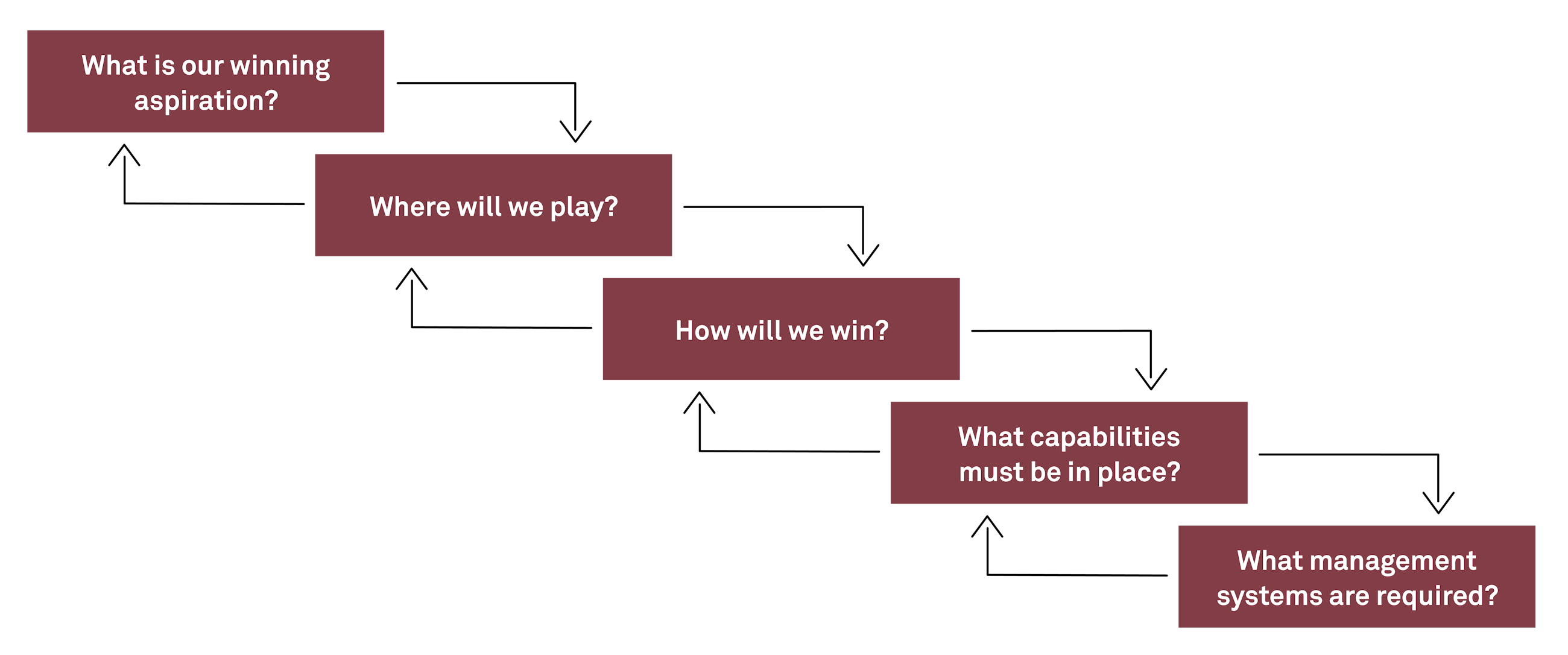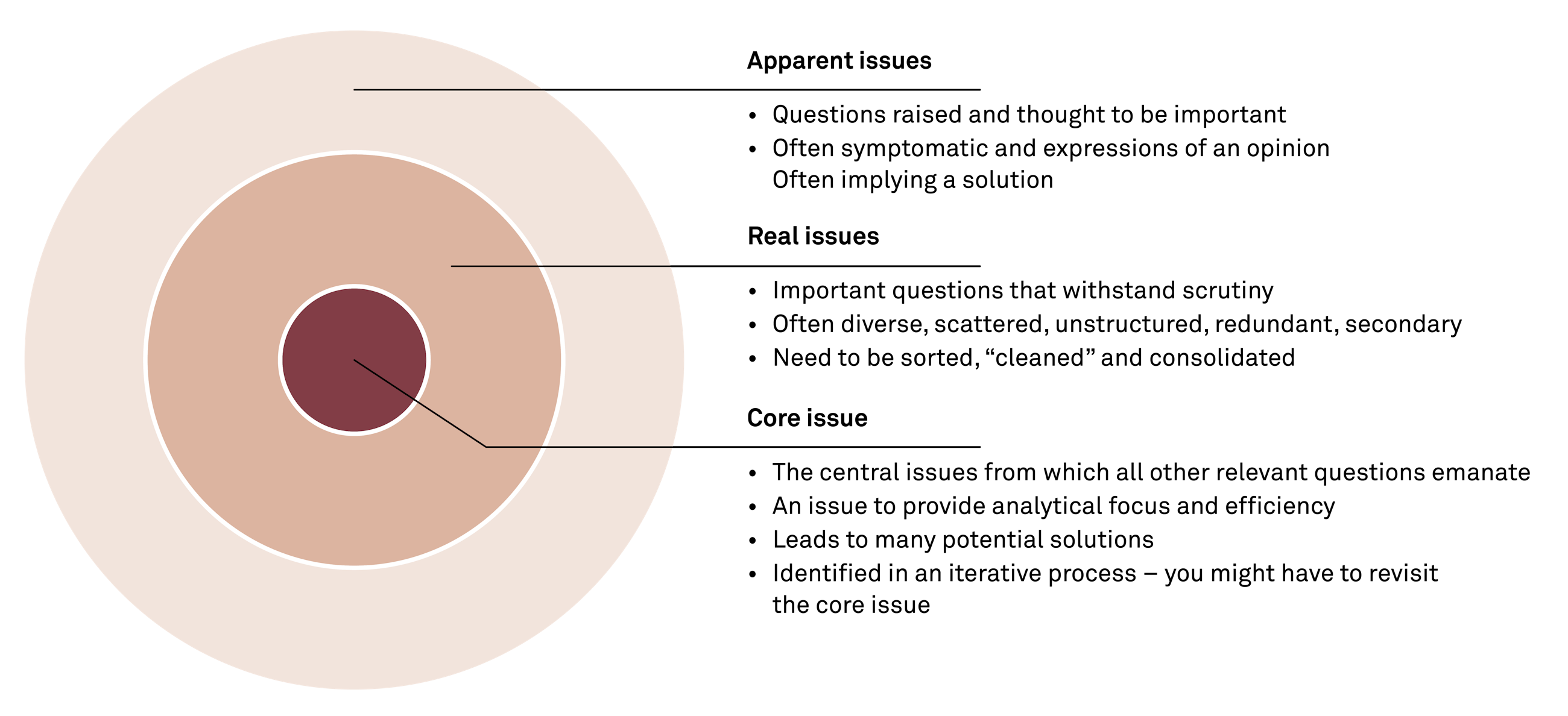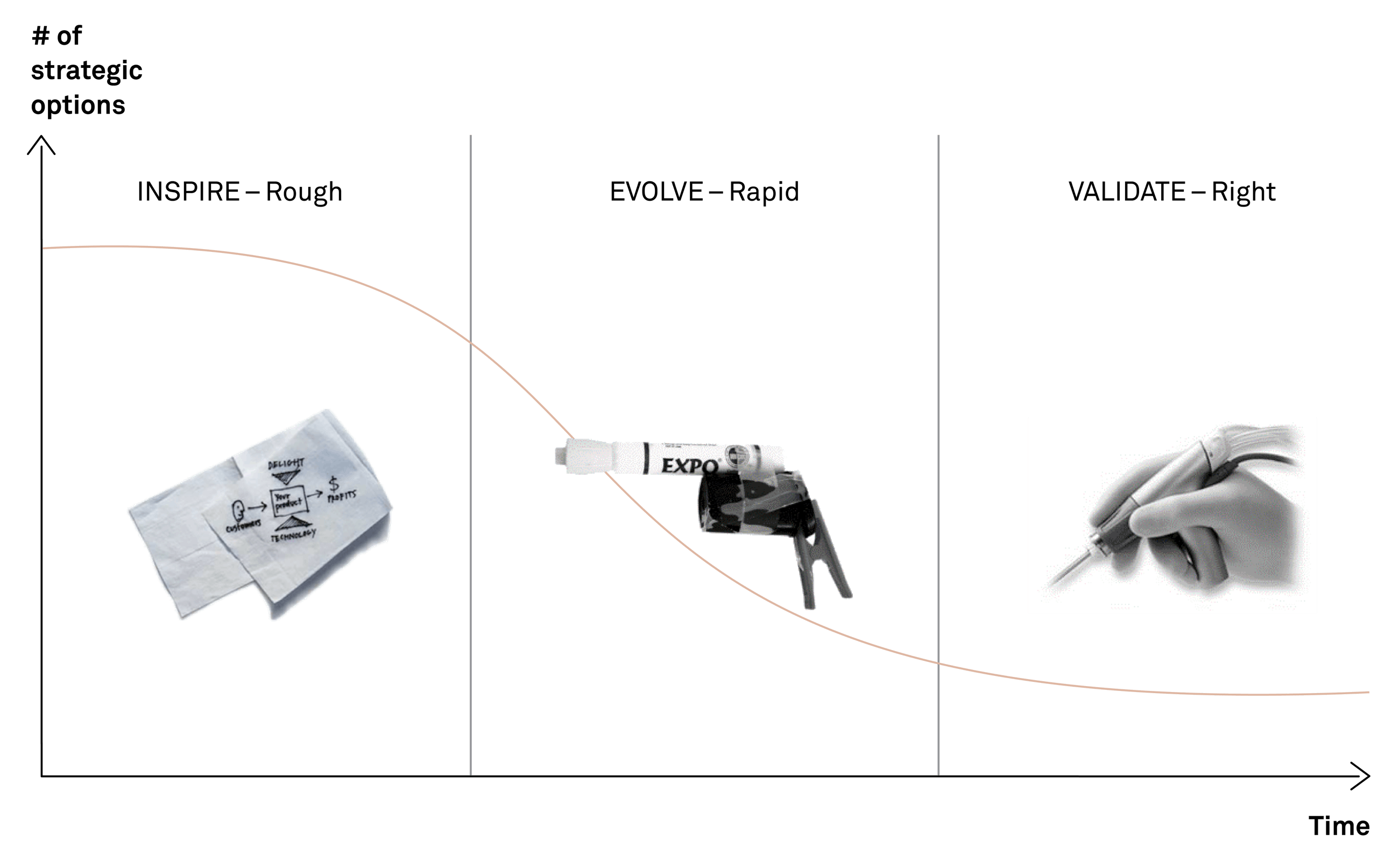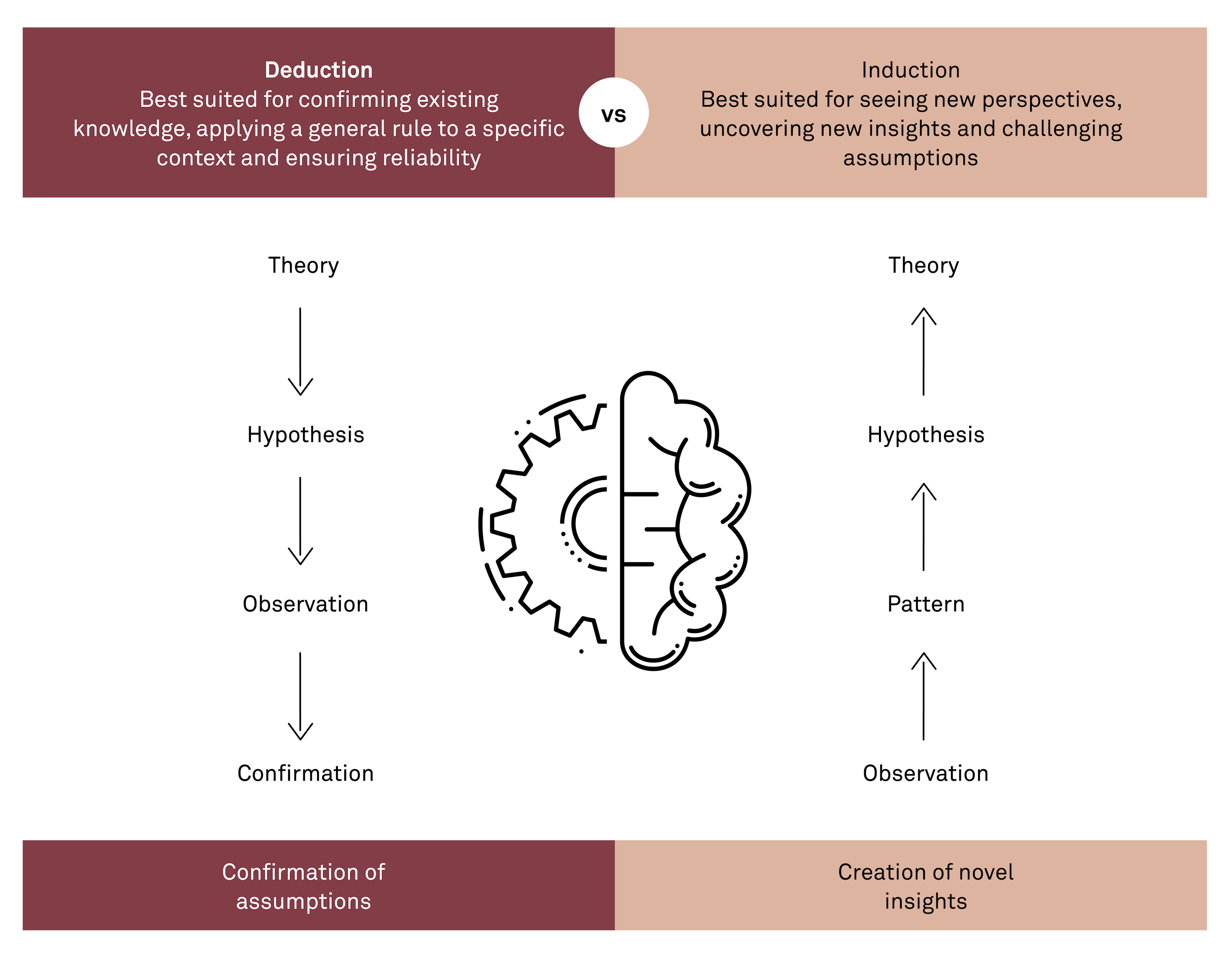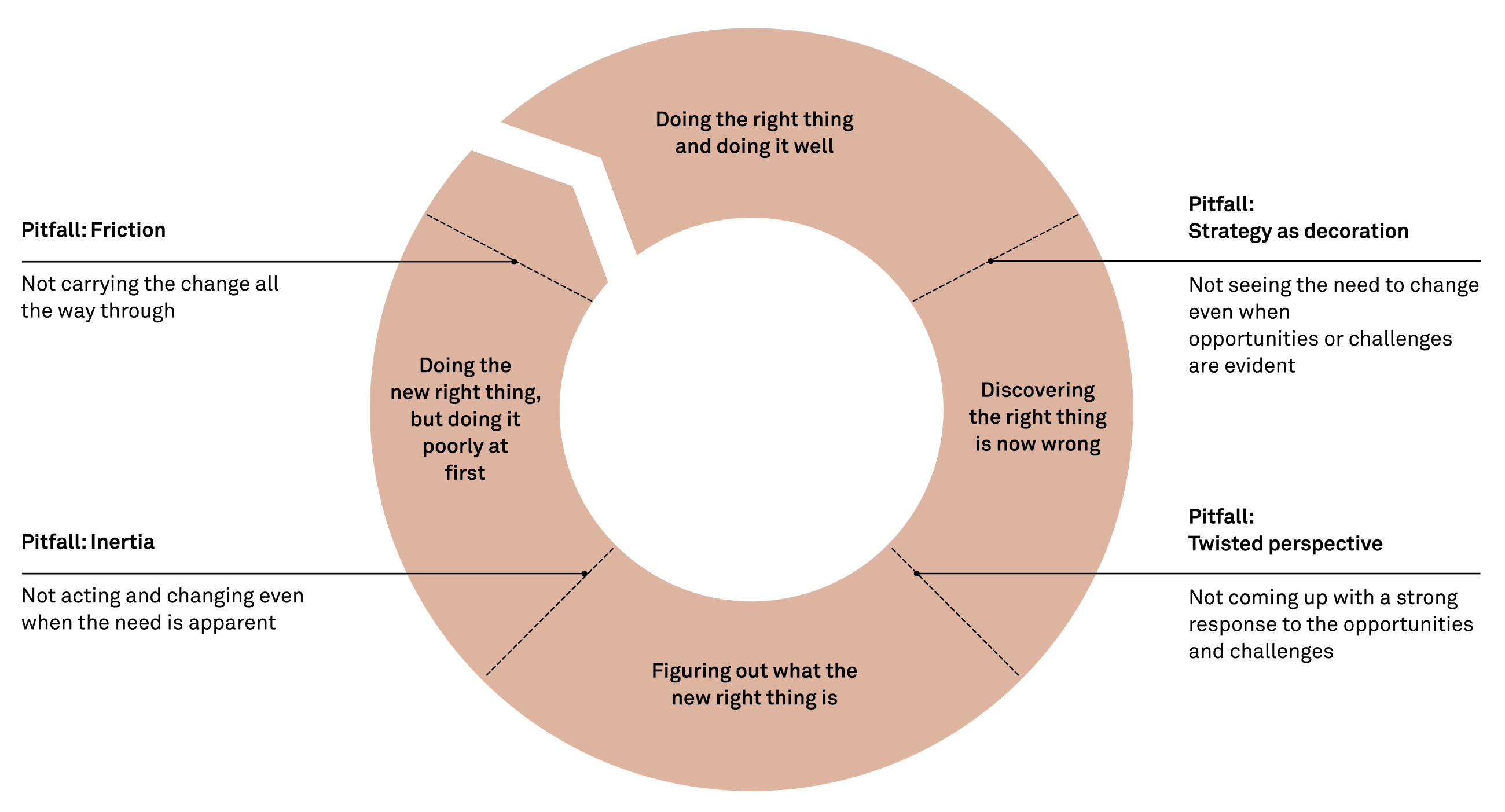Seven building blocks for better strategies
19 June 2017
As a business leader, a key task is to facilitate the creation of a shared aspiration and strategic direction for the organisation. Without a well-crafted strategy in place, the organisation is merely a collection of people pursuing individual goals, guided by what the organisation did yesterday. While there is no such thing as the perfect approach to strategy, we believe that we should constantly strive for improving our ways of leading strategy development to bring out the best of our organisations. Never stop questioning our practices. Always seek out better ways of working.
Based on Implement Consulting Group’s experience from working with some of the best-performing companies across Scandinavia and close collaboration with management thought leaders, we have gathered a collection of building blocks that we believe will help all organisations become more proficient at developing strategies that create real impact. Putting the building blocks together, they constitute the foundation for a new way of strategising. Individually, we hope that the blocks will provide you with food for thought.
#1 Challenge tradition: Recognise your strategy biases
In order to improve our ways of strategising, we need to start by taking a hard look at ourselves. An honest and open-minded look at the past is helpful to shed light on the fundamental assumptions that guide us as leaders when we do strategy. Did we manage to develop and implement a strategy that moved the needle in the right direction? That is the basic question.
The enquiry often reveals that our approach has not been designed in the optimal way. Mistakes made at the birth of the strategy are magnified mercilessly as strategy is transformed from idea to action. In our experience, three archetypical ways of developing strategy can be observed. These archetypes are exactly that. Pure archetypes. But they are useful for thinking critically about our biases and how to approach strategy development.
Reflecting on three different approaches to strategy
In the first way of working – the analytical approach – strategy is developed through a highly data-driven and analytical approach. The key idea is that strategy-making is a rational endeavour in which the right answers will improve significantly if analytical skills are applied in the right way. The job of the strategist resembles the role of a scientist, and the aim is to crunch data about customers, competitors and context to extract fact-based hypotheses about how to improve the organisational health and well-being. The analytical approach establishes a strong foundation of data and insights but often ends up in a lack of imagination, paralysis by analysis and thick unengaging reports.
In the second way of working – the sensemaking approach – strategy is developed through broad involvement of stakeholders and collective sensemaking about the future direction of the organisation. The key idea is that strategy starts and ends with the employees, and the process should aim at building a shared dream about the future. The job of the strategist resembles the job of a great coach that knows exactly which questions to ask to trigger engaging conversations, build motivation and ignite inner reflections. The sensemaking approach builds a tremendous momentum, but the strategy content often turns out to be the average of mixed opinions or in worst case the lowest common denominator.
In the third way of working – the intuitive approach – strategy is developed in a highly creative manner based on intuition, imagination and innovative thinking. The job of the strategist is closely related to the job of the artist, and the aim is to infuse creativity, obstruct conventions and conceptualise imaginative strategic moves. The creative approach can produce stellar ideas and disruptive thinking but typically fails to connect the radical ideas to organisational capabilities and realities.
Taking an integrated approach to strategy
We believe that all three methods should be mastered but never practised in isolation. There is a strong need for the analytical scientist, the sensemaking coach and the intuitive artist, but none of them will be very helpful if they are allowed to play the leading role in a solo performance. Crafting a winning strategy is a team sport, and you need to leverage all modes of thinking when working on strategy.
To lead the team, you might even need a fourth character on stage. The orchestrator. The orchestrator is responsible for questioning, observing and facilitating the strategy dialogue and conducting the strategy process in a way that seamlessly integrates the diverse perspectives represented by the other characters on stage. Further, the orchestrator must ensure that all performances reflect deeply on the genuine needs of the organisation. Do we need to turn the volume up or down for some voices? What is the nature of the strategic journey you are facing? And what is particularly important to focus on right now under the given circumstances?
Those and similar questions are all-important to ask at an early stage to navigate the pitfalls of developing a great strategy and to challenge traditional thinking on how to manage the process.
Tips for challenging tradition
- Question your assumptions about “the right” approach to strategy in order to challenge conventional thinking and approaches to strategy-making.
- Orchestrate strategy development as an interdisciplinary, cross-functional and collaborative design process.
- Balance analysis to produce insights, creativity to generate new perspectives and sensemaking to spur engagement at all stages.
#2 Make choices: Conceive strategy as creating and making choices
Metaphors are powerful. They help us make sense of the world and provide clarity. In our experience, the best metaphor for strategy is “choice-making”. This simple idea makes it evident that the essence of strategy is to make choices about what to do – and in particular what not to do.
When you make a choice, you are forced to focus, allocate scarce resources and to think hard about exactly how to be unique compared to competition. You can’t be everything to everyone. Cutting through complexity, this basic understanding makes strategy a lot easier to explain and to put into action. And in addition, the metaphor is helpful if we explore it even further.
Strategy is creating and making choices
To make choices, you need to create choices. Real choices cannot be made if you do not know what your options are and what options you are decisively rejecting. In most strategy processes, alternative strategic options are only considered superficially. But in a choice-oriented process, the imaginative process of creating attractive choices and considering all strategic options balances the analytical process of making choices based on scrutinising the assumptions that need to hold true for the choices to be viable. Intuition and analysis must complement each other.
Also, when you create and make choices, you enter into a collaborative process where different worldviews surface, and you need to unify conflicting opinions before you can devise effective actions. When you bring clarity to alternative options, you reveal difficult dilemmas, disentangle political agendas and force the organisation to discuss the tough trade-offs that are always inherent to any strategy.
Unfortunately, too many strategies are empty slogans and polished pitches, because they lack basic self-reflection about the options that the organisation purposefully chose not to chase. To put the idea about making choices centre stage is a call for a more authentic and self-reflective way of strategising. Let’s be honest about our convictions and unravel our biases.
A fast-growing high-tech company that we worked with took a choice-based approach to strategy. To establish a strong focus, the company had to zoom in on the most important strategic issues and clearly frame their choices. A key issue was signs of stagnating growth rates in the high-end markets that the company served at the time. Therefore, a key choice was whether to enter mid-end markets to reignite growth or to capture even more market share in the high-end. A wide range of strategic options spanning different business models and customer segments were created based on industry insights and creative thinking in the management team. In order to make choices, they prototyped and tested various options with key customers and through modelling different market scenarios.
At the end of the process, it became clear that the best solution was to reinforce and expand the current foothold in the high-end markets. In that way, the company’s strong brand was not compromised, and its strong technical capabilities were nurtured. But at the same time, customer feedback showed that they had to adjust the business model to keep up with competition. To build its position, the company now has a new partnership and co-development model for strategic accounts. This gets them closer to the needs of the most demanding customers and enables them to build strong customer relations that are hard to break for competition. The company’s market value has soared during the development and launch of the new strategy.
Getting firm on the key questions of strategy
While thinking about strategy as a process of choice-making is an essential starting point, we need to get more specific on what questions to answer when creating and making choices. Management thinker Roger Martin breaks down strategy into five interlinked choices that must be clarified to have a coherent strategy in place.
First, base your strategy on a clearly defined long-term winning aspiration that includes the broad aspirations and goals against which to measure progress. Second, the strategy must make choices about where to play and where not to play. Which markets, customer segments, product/service categories and value chain positions do you intend to win? Third, link the specific choices of where to play to specific choices of how to win. In contrast to the overall winning aspiration of your organisation, the choices of how to win should present the customer value proposition that will help you establish competitive advantage in the context of a given playing field. Fourth, determine what capabilities and assets are needed to build and maintain to deliver on the choices that you made. Fifth, look across capabilities and assets to define what management systems to put in place. The management systems represent the organisational design, governance setup, performance management systems and cultural foundation needed to glue the pieces together and make strategy work. Altogether, the five questions present a coherent and consistent set of choices that you need in order to have a strategy in place.
We recommend that business leaders think about strategy as a process of creating and making choices and that they take charge of orchestrating that process. In that way, leaders will be building on the best of what we already know about strategy – and at the same time take strategising to the next level. The next level of strategy is not about adding complexity, building more advanced simulations and making sure that all facts have been validated through extensive analysis. It is about simplifying the process, truly engaging and getting to decisive actions based on clear-cut choices.
Tips for creating and making choices
- Build a common understanding of strategy as the art of making distinct choices about how to win customers over competition.
- Spend as much time on creating choices as making choices by balancing creativity and analysis.
- Get firm on answers to the five key questions of strategy to build a granular understanding of key choices.
#3 Sharpen focus: Frame the right issues and cut the long tail of problems
Albert Einstein is often quoted for having said that if “he had an hour to solve a problem, he would spend 55 minutes thinking about the problem and 5 minutes thinking about solutions”. In other words, before taking a look at strategic options, we must make sure that we are framing the right issues and that stakeholders are fully aligned on the scope of the issues that we are working on in the strategy process. However, the quote should not lead us to conceive strategy development as a quasi-scientific problem-solving process. Two reasons spring to mind.
First, problem-solving-oriented efforts often turn into negative processes in which “the patient” is treated as being sick even before the first symptoms appear. In terms of building energy and engagement in the organisation, this way of working is destructive. Supported by evidence from recent advances in neuroscience, we now know that a more opportunity-driven approach ignites an appreciative and self-reinforcing focus on building on the best of what already is to unleash the full potential of the organisation. Problem-focused processes build demotivating “burning platforms” in your organisation whereas exploratory and appreciative processes create “burning desires”.
Second, a problem-focused approach typically makes it difficult to limit the amount of problems that need to be fixed. Picture a typical Indian city bus. Jam-packed with people and even more people hopping on the bus as it makes its way through heavy traffic. Problem-solving processes tend to end up just like this Indian bus. Strategy becomes a garbage can for all sort of organisational problems that somehow seem to fit into strategy. The end result is half-baked solutions and myriads of strategic initiatives. Therefore, we should cut off the long tail of problems.
Focusing on major strategic issues
A much better approach is to recognise that strategy is strategy. Not tactics or operations. That means going deep on a few strategic issues that truly have the potential to move your organisation in the long run. Go a mile deep and an inch wide. Focus on impact and what really matters. Not the other way around. This leaves room for thinking hard about creating and making choices.
Moreover, the result turns out to be much more manageable when implementation takes off due to a strong focus established upfront in the work. Less is truly more when it comes to strategy. Another advantage of directing attention to a handful of strategic issues is that it allows you to carefully investigate the framing of the issues. In fact, the framing process is often overlooked – as Einstein points out – because we naturally tend to jump into solution mode. For starters, issues should never be taken for granted whether the issue seems to be a great opportunity to be unfolded or a real and urgent problem that genuinely needs to be fixed.
Consider a major global truck manufacturer facing declining sales in after-sales services. What is the apparent issue? Well, the issue simply might be how to grow sales. Solutions could be as simple as training the sales force or gaining market share from unauthorised repair shops. But what if we scrutinise the issue a bit. Spend time, do a bit of analysis, challenge assumptions and zoom in and out. All of a sudden, it turns out that declining sales in after-sales was caused by dramatically improved quality of trucks. The trucks simply don’t break down or need as many repairs as earlier. What is the issue? Well, now it turns out that we have a systemic business model challenge. Challenging perceptions and gut feelings revealed that the overall business model was unsustainable, and we needed to reframe our thinking about the issue.
The example shows that the job of the strategist is to facilitate an in-depth discussion about the right issue framing. Before even thinking about potential options and creating choices, it is pivotal to start in the right way. The quality of the strategic choices made is closely tied to the quality of the issues defined.
Framing strategic issues in practice
A few tips from experience will help frame the right issues. Simply, spend sufficient time and learn to enjoy the uncomfortable messiness of not having a clearly defined issue. Help the framing process by conducting a bit of analysis on key assumptions and go back and forth between alternative issue framings. In some cases, you need to obstruct issue framing by breaking away from ordinary thinking patterns. This should include developing an issue tree that zooms in on very small details and zooms out beyond the initial thinking to get to even higher levels of abstraction before arriving at satisfactory issues.
Also, the process of framing the issue should always be highly collaborative and include involvement of key stakeholders. Experience shows that no issue framing survives the first contact with stakeholders. And having deep conversations about how to prioritise the issues will help sharpen the focus of the process. Last but not least, you must capture all issues in a way that leads towards creating choices and producing many alternative solutions. Do not imply the solution in the issue.
Obviously, the point is that we need to spend time framing the right issues. This part of the strategy process is often overlooked and not perceived as sexy as the art of combining intuitive and analytical thinking to create great strategic options. But as a matter of fact, it is the most important. Einstein was right. Garbage in. Garbage out.
Tips for sharpening focus
- Make sure to focus your efforts on the most impactful and uncertain strategic issues that may truly change the direction.
- Ensure full alignment about the understanding of the scope of the strategic issues across all key stakeholders.
- Challenge initial definitions of issues by reframing issues to uncover different perspectives and surprising points of view.
#4 Accelerate learning: Prototype to accelerate learning and improve strategic options
To master the process of creating and making strategic choices, you need to consider how you are going to investigate alternative strategic options. In contrast to traditional approaches, a choice-based approach starts with the assumption that there are multiple ways of making a problem go away or exploiting an opportunity. In other words, we must explore multiple options simultaneously for each strategic issue.
At the beginning of the strategy process, creative thinking helps us create hundreds of raw ideas and make a lot of rough sketches before concentrating on a handful of really attractive options. These options are then discussed and described comprehensively.
Prototyping multiple strategic options in parallel
Typically, we tend to fast-forward and select one strategic option at the expense of other attractive options. Let’s select the winner and get moving! However, if we can learn to let go of the traditional linear way of thinking and instead work iteratively on multiple options, chances are that real magic will happen.
The guiding principle is to postpone premature decision-making and start a process of fast prototyping to ensure fast learning. Strategy is not about perfection but rather about making choices that will shorten the odds of success. And the best way to improve the odds is to test-drive the options as fast as possible. Mistakes at this point are very cheap while they can be devastatingly costly at a later stage if the wrong strategy is implemented.
When you prototype, you get the opportunity to get fast feedback and improve strategic options. A prototype can be anything from simple drawings or simulations (low-fidelity) to something that allows customers and stakeholders to get a realistic sense of the strategic option (high-fidelity).
For instance, a FMCG company that we worked with redesigned the packaging and tested consumer response to a new brand in that way – without changing the contents of the packages and developing the actual product line. A high-tech company mocked up a new website very quickly in order to have dialogues with potential customers on their new strategy for a new customer segment.
Reaping the benefits of prototyping
The act of prototyping serves multiple purposes. First, it is a way for you to accelerate learning about key uncertainties and risky assumptions. Second, it helps stakeholders create a shared understanding by turning strategic opportunities into tangible artefacts. Third, prototyping requires integration and simulation that brings the different elements of a strategic option together to test the fit and interdependencies between various elements. Fourth, prototyping produces tangible results as opposed to endless slide decks that are continuously polished.
Currently, the financial services sector is challenged by increased regulatory demands, exponential technology developments and massive venture investments in starts-ups aiming at disrupting incumbent players. To deal with the high level of volatility, a financial services company explored a number of strategic options. These options ranged from integration of services to customer-centric solutions to disintegration and unbundling of services to support seamless integration with external platform providers and distribution partners. Comprehensive concepts were developed and prototyped for each of the options. Based on learning and feedback, the company reworked and merged the original options into new ones that could help them find a viable path forward in a highly volatile sector. The top management team was highly courageous to divert from a traditional linear decision-making process and to allow a much more imaginative process of creating and refining strategic choices.
Obviously, the art of prototyping is not entirely new to business leaders. A favourite prototyping tool has been business case simulations in spreadsheets. But the time has come to expand the toolbox and harvest the benefits that designers and engineers have experienced for many years when prototyping. As in the case of the financial services company, it often turns out that the process of prototyping helps to uncover novel ways of combining seemingly opposing elements across strategic options. This fact underscores that the best strategic options are developed in an iterative style with multiple feedback loops in order to build, test and learn fast.
Tips for accelerating learning
- Prototype multiple strategic options in parallel in order to investigate different answers to the same issue.
- Utilise different prototyping techniques to both generate new strategic ideas and validate assumptions.
- Leverage prototyping as a way of engaging and involving stakeholders in discussions about the future.
#5 Test assumptions: Take a scientific approach to making choices
Let us be honest. Developing a strategy is not an exact science. Rather, it is a complex process compromising a range of social interactions, qualitative interpretations and quantitative justifications. However, the inherent complexity of developing a strategy should not make us compromise on the basic integrity and validity of the choices we are creating and making. We must make sure that analysis supports our goals and is conducted in the right way.
If we think about strategy as the process of creating and making choices, it helps us in directing our attention to the most valuable types of analysis that will support the process. Obviously, there are literally millions of research methods and highly specialised analysis tools out there. Here we need experienced expert analysts to help us out. But as a business leader orchestrating the strategy process, the essence is to understand two very different approaches to analysis.
Stimulating creativity to create choices
Strategy is about creating choices that will give rise to a differentiated position in the marketplace. In other words, we need to think creatively about being different. Strategic options do not pop up out of the blue but rather emerge from our experience and knowledge. We build on what we already know. In some cases, all you need is a diverse group of experienced and creative thinkers. Strategic options will literally pour out.
However, experience does not always suffice, and if that is the case, we are trapped by thinking of the past. Therefore, a key question is how to generate unique insights that will unlock sufficient creativity and challenge conventional thinking. To that end we must design analyses that are primarily based on an inductive logic aiming at exploring the world qualitatively to provide fresh insights, uncover emerging trends or develop new hypotheses.
It might sound a bit theoretical, but implications are very real. Consider hitting the streets to observe real-life in action taking careful notes, studying solutions in other industries than your own and conducting in-depth interviews with target customers on their needs and desires. Then consider sitting at the desk reviewing historical data on buying patterns, doing a benchmarking against competitors and conducting a full customer survey on buying behaviours. In the first example, you will have the opportunity to stumble upon new insights and surprising facts whereas you can merely confirm or reject existing assumptions about the customers in the second case. What is the best option if you aim to fuel creative thinking? The answer is obvious if you were forced to make a choice. As a leader, a key task is to ensure the right amount of inspiration. Don’t boil the ocean, but spot the few inputs that are genuinely needed to get started thinking about options.
Validating assumptions to make choices
Moving from creating choices to making choices, our analysis needs to shift from uncovering novel insights towards confirming the feasibility of the strategic options that we have created before making a final choice. This means a shift in analysis from an inductive logic towards a deductive logic in which we test the underlying assumptions of the strategic option being investigated. The most important question before making a strategic choice is asking: What needs to hold true for the choice to be a great choice? In other words: What are the underlying assumptions that we will have to accept when making the choices? How important are the assumptions? How risky do we think the assumptions are? How might we conduct a valid and reliable test for the most important and risky assumptions? Asking these questions changes strategic choice-making from an act of emotional conviction into a matter of verifying key assumptions in a manner that gets as close to the scientific method as possible.
In the process, we typically find that making a decision boils down to a few critical assumptions that need to be validated. Agreeing on assumptions and testing standards as a team also puts a damper on latent conflicts that might appear if there is disagreement about choices. Tests are conducted in an arm’s length way so that choosing is not a matter of conviction and polishing business cases. Choosing is a matter of assessing test results as objectively as possible.
Looking across the strategy process, it is evident that we need both types of analysis modes. Induction will provide insights and show us new avenues for generating bright ideas. Deduction will help us conduct valid tests to determine if critical assumptions are true.
As mentioned, strategy is not a hard science, but a bit of methodological housekeeping will bring a lot of benefits. On one hand, you can limit that endless amount of analysis that tends to be conducted upfront by less experienced strategists. On the other hand, you can help identify critical assumptions and define valid tests to confirm or reject the exact strategic path you are pursuing. Moreover, the set of assumptions will provide you with an early warning system of key factors to be monitored during strategy implementation. The logic is clear-cut. If critical assumptions change significantly, somebody needs to act decisively on the new signals.
Tips for testing assumptions
- Make sure to uncover, prioritise and test critical assumptions that need to hold true for all potential strategic options.
- Involve key stakeholders and decision-makers when identifying assumptions and designing tests to ensure full alignment.
- Apply the right approach to analysis, balancing inductive generation of novel insights with deductive tests of key assumptions.
#6 Build energy: Engage for sensemaking and aim for co-creation
Research shows that more than 70% of strategies fail to reach their desired objectives. Digging deeper into the numbers, a key driver behind this truly disappointing finding proves to be “a lack of alignment behind strategy”. In our experience, this insight unfortunately leads many business leaders to believe that getting alignment is a matter of convincing the organisation to act differently. The tools typically used are persuasive presentations, brilliant storytelling, instructive guidelines and motivating incentives. All these tools surely play an important role, but they all rely on “selling and telling” tactics that consistently have proven to be ineffective compared to other approaches.
Moving from “selling and telling” to “explaining and helping”
When we are “telling” someone explicitly to act in a different way, we often unintentionally ignite a large amount of scepticism and inner resistance at the receiving end. Why? We implicitly state that we are more knowledgeable than the person we expect to change behaviour. We have the answer – just listen. We ask the person to suppress own ideas, and thereby we eliminate a sense of autonomy and of being in self-control. We challenge the status quo and the comforting certainty about doing more of what the person was already doing. Altogether, we do not create a flow of energy and build momentum. We drain it.
Here the metaphor of strategy as choice-making proves to be helpful. Making choices is not something abstract that happens at some theoretical organisational level. Organisations themselves do not accomplish anything. Endeavours succeed or fail because of the people involved and the explicit choices that everyone is making every day. In that way, broad choices made at corporate level are connected in a close-knit cascade down to the very concrete choices employees make at the front line. That is why a starting point for improving our ability to make strategy work is to go from a “selling and telling” approach to an “explaining and helping” approach.
Instead of telling people what to do, business leaders should rather respect the autonomy and expertise of their employees and explain the choices they have made to help employees frame their own choices so that they fit into the overall choice cascade. Further, it is key to be responsive so that feedback on choices is captured and reviewed. The goal of the business leader must be to support the choice-making process in flourishing at all levels.
Moving from “explaining and helping” to “listening and co-creating”
Taking a closer look at the strategy process, a key insight is that to build energy in the organisation, strategy development and strategy implementation should not be separated. In fact, implementation starts from day one. This might seem counter-intuitive from a purely rational point of view. If we have not made any choices yet, how can we start to think about implementation? However, strategy is not a purely rational undertaking. Strategy-making is all about the people. And people are all about emotions and relations as well as rational thinking. Therefore, every interaction and every touch point in the strategy development process holds the potential to make or break the energy needed to create a tipping point towards a new strategic direction.
If we are to bridge development and implementation, our odds of success improve significantly if we are able to act even more proactively than described above. That means shifting from “explaining and helping” towards “listening and co-creating” throughout the strategy process where possible. In this way, everyone is appreciated as valuable contributors and important players that can give input to shaping the strategic choices. Ideally, we should aim for turning strategy into a real, engaging and authentic dialogue-based process at all times. If we succeed, we will strengthen the common sense of purpose and ignite a burning desire for supporting the new direction.
Consider a market-leading building materials producer that was facing rapid market changes due to the financial crisis and increased market focus on energy-efficient buildings. The situation called for change and a new strategy. A pivotal part of the strategy development process was early involvement of both the top management team and the extended management team in co-creating the new strategic direction. Through large-scale workshops, more than 160 global managers were invited to contribute to the process to establish shared ownership of strategic choices. Furthermore, the events were also leveraged to work on new corporate values and to discuss the leader’s own role in making strategy happen on a very personal level. According to the CEO, this ensured a high degree of momentum and feeling of empowerment throughout the organisation as mid-level managers took early ownership.
The top management team of a high-tech company started a corporate strategy process by openly inviting all employees to suggest major investments that they would like to be made in order to radically accelerate growth. What would you do if you could decide on your own right here and right now? All suggestions were collected, analysed and used as an important input in the strategy process. Almost all employees participated. Some suggestions were brilliant strategic ideas. Other suggestions were less noteworthy. However, everyone expressed a true commitment and interest from day one in strategy-making.
Both cases show that developing the strategy and building energy for implementation were closely connected from day one.
Obviously, we cannot involve everyone at all stages. Hence, the job of the business leader is to design a process that carefully handles the trade-off between building bottom-up momentum and letting key stakeholders set direction top-down. However, the starting point for managing the trade-offs is for every business leader to perceive herself as a facilitator of sensemaking and choice-making at the individual level – and not to be a heroic visionary who enthusiastically tells the organisation what to do.
Tips on building energy
- Design the strategy process carefully to involve key stakeholders from day one in identifying issues and co-creating strategic answers.
- Leverage innovative large-scale facilitation and involvement techniques that help drive real engagement at scale.
- Think carefully about communicating strategic choices in a way that productively engages the organisation and helps employees frame their own choices.
#7 Stay agile: Be adaptable to change and sensitive to weak signals
Looking across business books, a rough estimate is that 90% start with touting that we live in times of great turbulence and uncertainty. Some books even claim that we are moving into a period of exponential change. It is almost a cliché. Nevertheless, the accelerating forces of change confront business leaders with new challenges when it comes to thinking about strategy. This has led some thinkers to declare strategy dead as a value-adding discipline. Why strategise if we cannot predict the future?
On one hand, classic long-term strategic planning practices are proving less successful in a world of accelerating change. Issues are getting tougher, competition is becoming less predictable and complexity levels are on the rise. On the other hand, strategy is still fundamentally about making distinct choices, allocating scarce resources and placing bets for the future. These practices are still very much valid, but we need to balance long-term ambitions with short-term agility.
According to our experience, many organisations have not acted on the increasing levels of turbulence in a timely manner. Most organisations are stuck in classic strategic planning practices and tend to regard strategy development as something that is first and foremost embedded in a formal organisational process governed by certain rituals. These rituals usually prescribe that every three to five years, strategy is adjusted and the new strategy is subsequently implemented according to plans.
The ritual might sound outdated. However, according to our experience the surprising insight is that if conducted in the right way, this ritual still creates a lot of value. Timely staged discussions on strategy leading to decisive long-term choices for the future and broad alignment across the organisation make sense. Strategy rituals install a steady heartbeat and a staged process for allowing the organisation to reflect on the future and synchronise actions. Strategy is not at all dead. It is very much alive. However, if industry turbulence is indeed increasing, we need to move beyond the classic way of strategising and ensure that strategic choices are investigated and adjusted at a higher pace.
Responsiveness to changes in key assumptions
To update classic strategy processes, we must act in a much more responsive way to changes in the underlying key assumptions of the strategy. This requires the organisation to set up a well-defined process for monitoring key assumptions on a continuous basis and define simple rules for when and how to act on changes in critical assumptions. Strategy should be decisively implemented as long as the underlying assumptions hold true. But the second a critical assumption turns into a red flag, leaders must rapidly stop, think and act.
Consider the electric vehicle industry. For years, developments have been rather unpredictable due to uncertainties regarding, among other things, political regulations, technology trends, supply of attractive cars and consumer demands. This led one player in the industry to develop four distinct market scenarios based on different assumptions and four corresponding sets of strategic choices. This helped the management team to have frequent informed discussions on whether the market was entering a new scenario and which strategic choices to adjust accordingly. And instead of having endless discussions, they could leverage their shared understanding of the underlying assumptions and the specific trigger points that required the team to act decisively.
Sensing and seizing emerging opportunities
While being responsive to changes in the underlying assumptions is vital, it will not suffice. We must also act in a much more proactive way to sense and seize emerging opportunities. This requires organisations to think about strategising in a whole new way. Monitoring known assumptions must be supplemented with organisational intelligence systems that are capturing and making sense of the unknown. For instance, weak signals on emerging technologies, subtle changes in customer needs or changing venture investment levels in start-ups with potentially disruptive business models.
Whereas monitoring changes in key assumptions should be driven as a formal top-down process, the proactive ability to explore and exploit new opportunities in times of faster change requires distributed responsibility. If we insist on fixing all issues in the formal strategy development process, chances are that we will go too slow and get stuck in systemic bottlenecks. Consequently, more and more organisations are moving beyond traditional planning processes by decentralising decision-making responsibility and democratising strategy by building capabilities for making strategic choices and solving complex business issues across the organisation. That means establishing a shared language around creating and making strategic choices, building and nurturing a common strategy toolbox and designing management systems supporting the capability. In the search for agility and resilience, organisations must combine well-crafted top-down processes for strategising with a broadly held capability for acting on opportunities bottom-up in a much more agile way.
Currently, incumbent players in the media industry are facing a lot of turbulence. New entrants, disruptive technologies and value chain shifts are changing the game. To stay agile and proactive, a major media player decided to develop a strong capability for strategising among both top management and mid-level managers. In this way, business leaders across the organisation were equipped with a common approach and mindset for handling the dynamics of the industry. The initiative included both developing the capabilities and rearranging management systems so that old governance structures and leadership styles were updated to fit with a new way of working that encouraged a much broader group of leaders to spot issues, create options, make choices and put strategy into action. Further, a positive side effect was that motivation went up as mid-level managers now felt more involved and empowered to act on emerging opportunities.
Putting the pieces together, organisations upgrading their strategy capabilities are balancing two interconnected routes to success. Firstly, they are making existing strategy processes suited for making long-term commitments lighter, simpler and better suited for making real strategic choices. Secondly, they are ensuring that the responsibility for strategic decision-making and the power to act are being distributed widely across the organisation in order to increase agility and adaptability to change.
The dual strategy operating system sounds appealing in theory. But striking the right balance between firmness and flexibility in practice is challenging and requires business leaders to design a whole new model for making strategy work. The core idea is that we must build on the best of both paradigms. If stuck in the old ways of working favouring control and alignment, the odds of meeting your Kodak or Blockbuster moment will increase significantly due to lack of responsiveness and adaptability. If abandoning classic ways of strategising to work in a much more agile fashion, most likely you will end up losing a common sense of long-term direction and find yourself muddling through on a day-to-day basis. That is the challenge facing business leaders and strategists today. In our experience, we will get a glimpse of the solution to the challenge when putting all the building blocks for better strategies into play.
Tips for staying agile
- Design a lean and simple governance structure for ensuring that strategy is frequently reviewed, continuously updated and systematically aligned across the organisation.
- Install a structured process for monitoring critical assumptions that need to hold true and agree on how to take decisive action if assumptions are challenged.
- Build broad-based capabilities for strategic problem-solving and decision-making among key leaders and business developers to increase agility.



